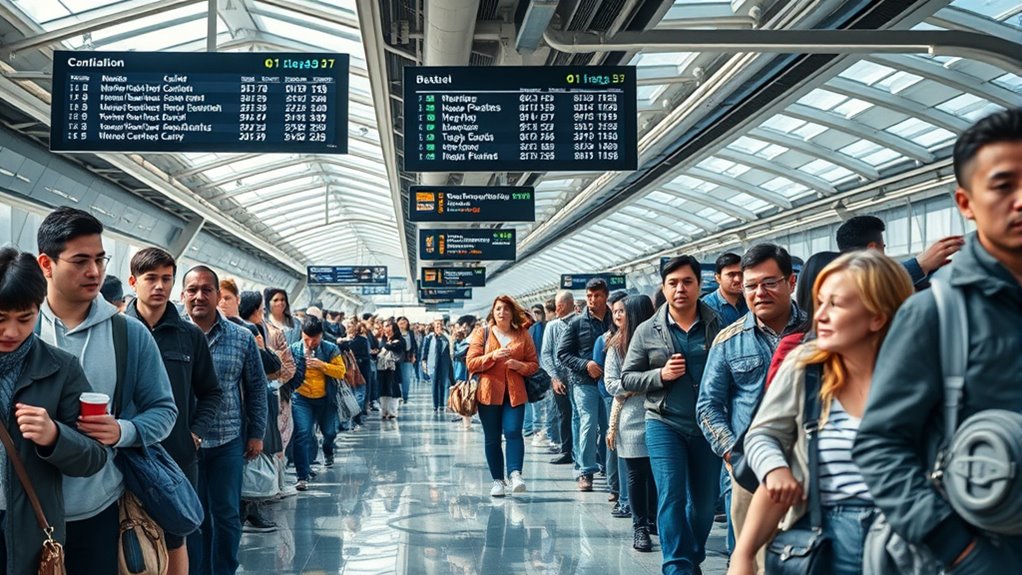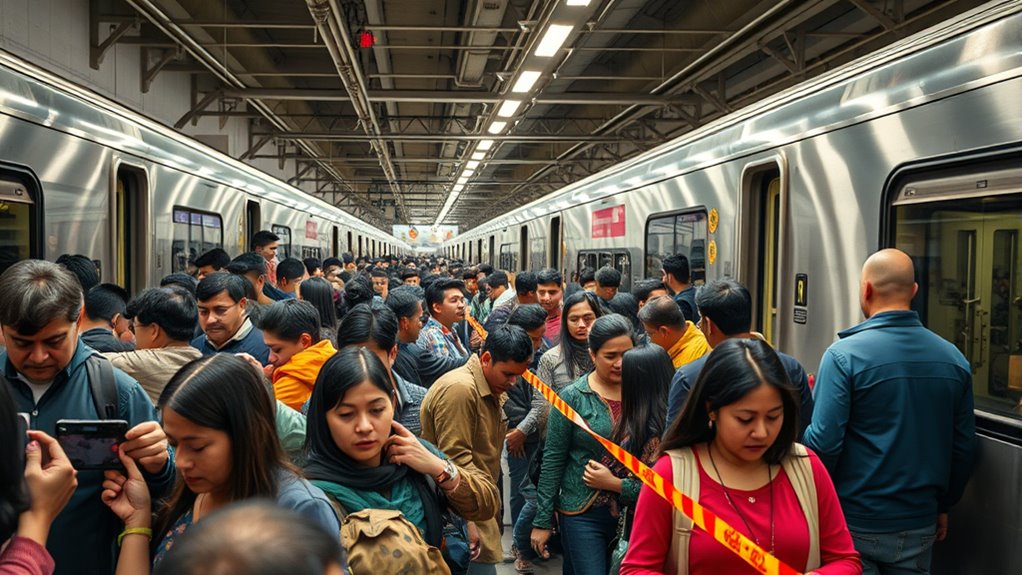To beat lines, identify peak times like after work or lunch and visit during off-peak hours. Use apps or online systems to check wait times or reserve spots. Look for express lanes or priority options to skip the longest queues. If lines seem too long, consider returning later or exploring alternative locations. Understanding these tactics can transform your wait into a quick, hassle-free experience—keep going to discover more advanced strategies.
Key Takeaways
- Schedule visits during off-peak hours identified through understanding typical peak times.
- Use priority lanes, reservations, or express options to bypass standard queues efficiently.
- Leverage technology like online check-ins and notifications to minimize physical waiting.
- Choose alternative locations or times if service capacity is limited or lines are too long.
- Estimate wait times and set realistic expectations to reduce frustration and improve planning.

Queueing theory offers practical tricks to optimize service systems and reduce wait times. When you understand the basic principles, you can make smarter choices about how to navigate lines and improve your overall experience. One key idea is that the length of a queue isn’t just about the number of people waiting—it’s influenced by how service times and arrivals are distributed. If you can spot patterns, you can often avoid the busiest times or choose the right moment to step in. For example, many stores and restaurants tend to have peak hours, usually right after work or during lunch. By scheduling your visits outside these times, you can skip the long lines and get faster service. It’s a simple trick that saves you time and frustration.
Another effective strategy involves understanding the concept of “queue discipline,” which is how customers are served. Many places use a first-come, first-served approach, but some use priorities or reservations. If you have the option to make a reservation or use an express lane, you can bypass the slower, standard queue. This is especially useful at busy airports, theme parks, or clinics. Knowing which lines are more efficient can help you plan better—sometimes, waiting a little longer for a dedicated lane pays off in the end. Additionally, recognizing service capacity is essential. If you notice that a particular service point is consistently slow, it might be worth exploring alternative options or times. Sometimes, switching to a different branch or store can considerably cut down your wait.
You can also leverage the idea of “balking” and “reneging,” which describe customer behavior in queues. If you see a line is too long or moving too slowly, you might decide to leave and come back later or try a different location. This simple decision can save you time and reduce stress. Conversely, if you’re managing a queue, understanding these behaviors can help you better estimate wait times and manage customer expectations.
Finally, technology plays an essential role in applying queueing theory tricks. Many businesses now offer online check-ins, appointment systems, or mobile alerts when it’s your turn. By using these tools, you can avoid physically waiting in line altogether. Instead, you’re notified when it’s your turn, so you can arrive right on time—saving you the hassle of standing around. Overall, by applying these principles, you gain more control over your time and can turn what seems like unavoidable waiting into a more manageable experience.
Frequently Asked Questions
How Can Queueing Theory Improve Customer Satisfaction?
Queueing theory improves customer satisfaction by helping you design efficient service systems that minimize wait times. By analyzing arrival rates and service capacity, you can optimize staffing and layout, ensuring customers are served quickly. This reduces frustration and enhances their overall experience. Implementing these strategies shows you value their time, building loyalty. In short, applying queueing theory makes your service smoother, faster, and more enjoyable for everyone.
Are There Software Tools to Simulate Queueing Systems?
Yes, you can find software tools to simulate queueing systems that help you optimize operations. These tools range from simple online calculators to advanced simulation platforms like Arena, Simio, or AnyLogic. They allow you to model different scenarios, analyze wait times, and improve service flow. By experimenting with these tools, you gain insights that help you make data-driven decisions, ultimately reducing wait times and boosting customer satisfaction.
What Industries Benefit Most From Queueing Theory Strategies?
You benefit most from queueing theory strategies in industries like healthcare, retail, transportation, and telecommunications. In healthcare, it helps reduce patient wait times and optimize staff schedules. Retail stores improve checkout efficiency, while transportation services streamline passenger flows. Telecommunications companies manage network traffic better, preventing overloads. By applying these strategies, you can increase efficiency, enhance customer experience, and lower costs across these sectors, making your operations more effective and competitive.
How Do Variability and Randomness Affect Queue Efficiency?
Variability and randomness are like unpredictable waves crashing against your ship, disrupting smooth sailing. They cause longer waits, bottlenecks, and uneven service, making the queue less efficient. When arrivals or service times fluctuate unexpectedly, your system struggles to maintain flow. To counter this, you need to add buffers and adjust staffing, smoothing out the chaos. Embracing these uncertainties helps you keep the line moving, even when waves of unpredictability hit.
Can Queueing Theory Be Applied to Digital Service Systems?
Yes, queueing theory applies to digital service systems. You can model server loads, response times, and customer wait times online using queueing models. This helps you optimize server capacity, reduce delays, and improve user experience. By analyzing traffic patterns and system behavior, you can adjust algorithms or resources proactively, ensuring smoother digital interactions. Implementing queueing principles in digital platforms allows you to efficiently manage high traffic and maintain service quality.
Conclusion
So, next time you’re stuck in a long line, remember—queueing theory isn’t just math; it’s a secret weapon. Oddly enough, the same tricks that ease your wait can also boost your business or daily life. Coincidentally, understanding these principles might just be the key to turning frustration into efficiency. Keep these tricks in mind, and you’ll find yourself beating the lines—and maybe even surprising yourself along the way.










